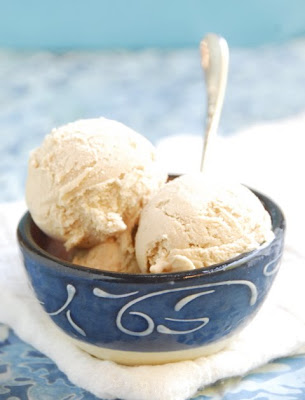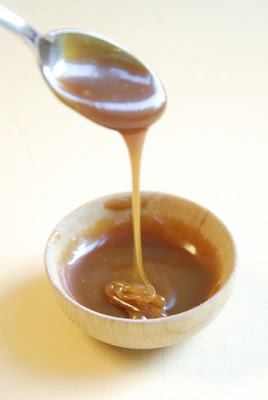

Sadly I had to give up gluten, so I made this bread but didn't eat it, it was torture let me tell you. I brought it up to the West Point Inn, an amazing place up on Mount Tamalpais, reachable only by foot, where we spent last night. I knew that our friends and their children would love having it for dessert or even for breakfast. We ate it at night and as french toast this morning, delicious! And to make you want to visit San Francisco, here are two pictures of this morning's sunrise, from the Inn, totally priceless!


Penny challenged to package the stollen for gift giving so I cooked few mini stollens in these super cute paper molds and gave them as gift to few of my neighbors.
You can find the complete recipe and instructions at the daring kitchen site, but below is just the recipe, edited to make the ingredient list easier to read.
I candied my own peel using the method I normally use, and used grapefruit and lemon peel since that is what I had at home.
I made few changes to the recipe, first in the mixing. I omitted 3 ounces of flour to the dough as the original 27 ounces seemed too much, I prefer a wetter dough in general, plus you can always add more flour if it is not enough. The amount I used, 24 ounces, worked well. Then I didn't add the butter until after the gluten started developing. Fat inhibits gluten development, by adding the butter slowly after the dough has been mixed a while you create a softer, more elastic dough. I used cranberries instead of the raisins to make the bread even more festive (the Germans don't use cranberries as they are a Northern American fruit), and didn't use the cherries the recipe suggests. Last change was in the spice, I used ground cardamom instead of the cinnamon, because it goes so well with the citrus flavor.
Stollen Wreath
Makes one large wreath or two traditional shaped Stollen loaves.
Serves 10-12 people
Ingredients
1/4 cup (60ml) lukewarm water (110º F / 43º C)
2 packages/4.5 teaspoons/14 gr/.5 oz active dry yeast
1 cup milk
5 oz/10 tablespoons/140 gr unsalted butter
5.5 cups/27 oz/770 gr all-purpose flour
½ cup/115 gr sugar
3/4 teaspoon/4.5 gr salt
1 teaspoon/6 gr cinnamon
3 large eggs, lightly beaten
Grated zest of 1 lemon and 1 orange
2 teaspoons/10 ml vanilla extract
1 teaspoon/5 ml lemon extract or orange extract
3/4 cup/4 3⁄4 oz/135 gr mixed peel
1 cup/6 oz/170 gr firmly packed raisins
3 tablespoons/45ml rum
12 red glacé cherries (roughly chopped) for the color and the taste. (optional) I didn't use them
1 cup/3.5 oz/100 gr flaked almonds
Melted unsalted butter for coating the wreath
Confectioners (powdered) sugar for dusting wreath
Directions
Soak the raisins
In a small bowl, soak the raisins in the rum (or in the orange juice from the zested orange) and set aside. See Note under raisins.
To make the dough
In a small saucepan, combine 1 cup (240 ml) milk and 10 tablespoons (150 ml) butter over medium - low heat until butter is melted. Let stand until lukewarm, about 5 minutes.
Lightly beat eggs in a small bowl and add lemon and vanilla extracts.
In a large mixing bowl (4 qt) (4 liters) (or in the bowl of an electric mixer with paddle attachment), stir together the flour, sugar, salt, cinnamon, orange and lemon zests.
Then stir in (or mix on low speed with the paddle attachment) the yeast/water mixture, eggs and the lukewarm milk/butter mixture. This should take about 2 minutes. It should be a soft, but not sticky ball. When the dough comes together, cover the bowl with either plastic or a tea cloth and let rest for 10 minutes.
Add in the mixed peel, soaked fruit and almonds and mix with your hands or on low speed to incorporate. Here is where you can add the cherries if you would like. Be delicate with the cherries or all your dough will turn red!
Sprinkle flour on the counter, transfer the dough to the counter, and begin kneading (or mixing with the dough hook) to distribute the fruit evenly, adding additional flour if needed. The dough should be soft and satiny, tacky but not sticky. Knead for approximately 8 minutes (6 minutes by machine). The full six minutes of kneading is needed to distribute the dried fruit and other ingredients and to make the dough have a reasonable bread-dough consistency. You can tell when the dough is kneaded enough – a few raisins will start to fall off the dough onto the counter because at the beginning of the kneading process the dough is very sticky and the raisins will be held into the dough but when the dough is done it is tacky which isn't enough to bind the outside raisins onto the dough ball.
Lightly oil a large bowl and transfer the dough to the bowl, rolling around to coat it with the oil. Cover the bowl with plastic wrap.
Put it in the fridge overnight. The dough becomes very firm in the fridge (since the butter goes firm) but it does rise slowly… the raw dough can be kept in the refrigerator up to a week and then baked on the day you want.
Shaping the Dough and Baking the Wreath
1. Let the dough rest for 2 hours after taking out of the fridge in order to warm slightly.
2. Line a sheet pan with parchment paper.
3. Preheat oven to moderate 350°F/180°C/gas mark 4 with the oven rack on the middle shelf.
4. Punch dough down, roll into a rectangle about 16 x 24 inches (40 x 61 cms) and 1⁄4 inch (6 mm) thick.
Starting with a long side, roll up tightly, forming a long, thin cylinder.
Transfer the cylinder roll to the sheet pan. Join the ends together, trying to overlap the layers to make the seam stronger and pinch with your fingers to make it stick, forming a large circle. You can form it around a bowl to keep the shape.
Using kitchen scissors, make cuts along outside of circle, in 2-inch (5 cm) intervals, cutting 2/3 of the way through the dough.
Twist each segment outward, forming a wreath shape. Mist the dough with spray oil and cover loosely with plastic wrap.
Proof for approximately 2 hours at room temperature, or until about 11⁄2 times its original size.
Bake the stollen for 20 minutes, then rotate the pan 180 degrees for even baking and continue to bake for 20 to 30 minutes. The bread will bake to a dark mahogany color, should register 190°F/88°C in the center of the loaf, and should sound hollow when thumped on the bottom.
Transfer to a cooling rack and brush the top with melted butter while still hot.
Immediately tap a layer of powdered sugar over the top through a sieve or sifter.
Wait for 1 minute, then tap another layer over the first.
The bread should be coated generously with the powdered sugar.
Let cool at least an hour before serving. Coat the stollen in butter and icing sugar three times, since this many coatings helps keeps the stollen fresh - especially if you intend on sending it in the mail as Christmas presents!
When completely cool, store in a plastic bag. Or leave it out uncovered overnight to dry out slightly, German style.









































